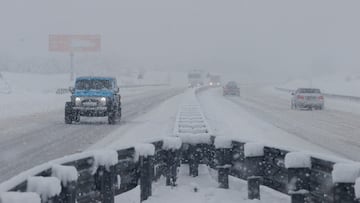This is how much snow is needed in a winter storm to be considered “heavy snow”
Heavy snow is a term thrown around just before a major storm, but there is a standard definition used by the National Weather Service.


The United States has been affected by severe weather this month, with some areas experiencing extreme danger from wildfires while others have been buried under snow. Communities in Texas and Georgia, which are far less accustomed to snow, recorded between 5 and 12 inches of snowfall last week. Some might describe this snowfall as “heavy,” but what does that term mean? Is there an official definition?
Yes. According to the National Weather Service (NWS), “heavy snowfall” is a term meteorologists use when snowfall accumulates to four inches or more in twelve hours or six inches or more in twenty-four hours. The NWS notes that “snowfall amounts are expressed as a range of values, e.g., ‘8 to 12 inches,’” but when heavy snowfall is expected. If there is “uncertainty concerning the range of values,” the agency states it is “more appropriate” to say that up to a certain amount of snow is expected.
When does the NWS issue a heavy snow warning?
These alerts are issued when meteorologists predict that at least six inches of snow could fall within a twelve-hour window, or eight inches within a twenty-four-hour period, or when conditions conducive to that level of snowfall are imminent.
The heavy snow designation was implemented by the NWS for the contiguous United States to avoid confusion between different offices of the weather agency. “Changes are being made to eliminate non-meteorological discontinuities such as NWS office boundaries, adjust the length of time from a specific time frame to the overall event (not to exceed 48 hours), and improve decision support services and communication,” reported the agency when the decision was made. Nevertheless, there are exceptions in the Midwest, where heavy snowfall is common, and thus, the NWS allows offices to adopt an individualized definition within the confines of the rules above. For instance, in Central Illinois, a heavy snow warning will be issued for
Fulton, Knox, Marshall, McLean, Peoria, Stark, Tazewell, and Woodford Counties
when six inches are expected, while in
Champaign, Christian, Clark, Clay, Coles, Crawford, Cumberland, De Witt, Douglas, Edgar, Effingham, Jasper, Lawrence, Logan, Macon, Mason, Morgan, Moultrie, Piatt, Richland, Sangamon Scott, Schuyler, Shelby, and Vermilion Counties
the alert is triggered when only five inches are forecasted.
The importance of standardization
The work of the NWS is critical to ensuring public safety, as these alerts help residents prepare and understand what to expect. However, the designation also takes into account that, based on geography, what residents consider heavy snow can vary significantly. In the southernmost portions of the Lower 48, even a few inches of snow can disrupt daily life and strain infrastructure, affecting residents' lives.
Therefore, the NWS permits each office to determine what constitutes heavy snow for their specific region. A map illustrating these regional definitions is available on the NWS website.
Related stories
Get your game on! Whether you’re into NFL touchdowns, NBA buzzer-beaters, world-class soccer goals, or MLB home runs, our app has it all.
Dive into live coverage, expert insights, breaking news, exclusive videos, and more – plus, stay updated on the latest in current affairs and entertainment. Download now for all-access coverage, right at your fingertips – anytime, anywhere.
Complete your personal details to comment